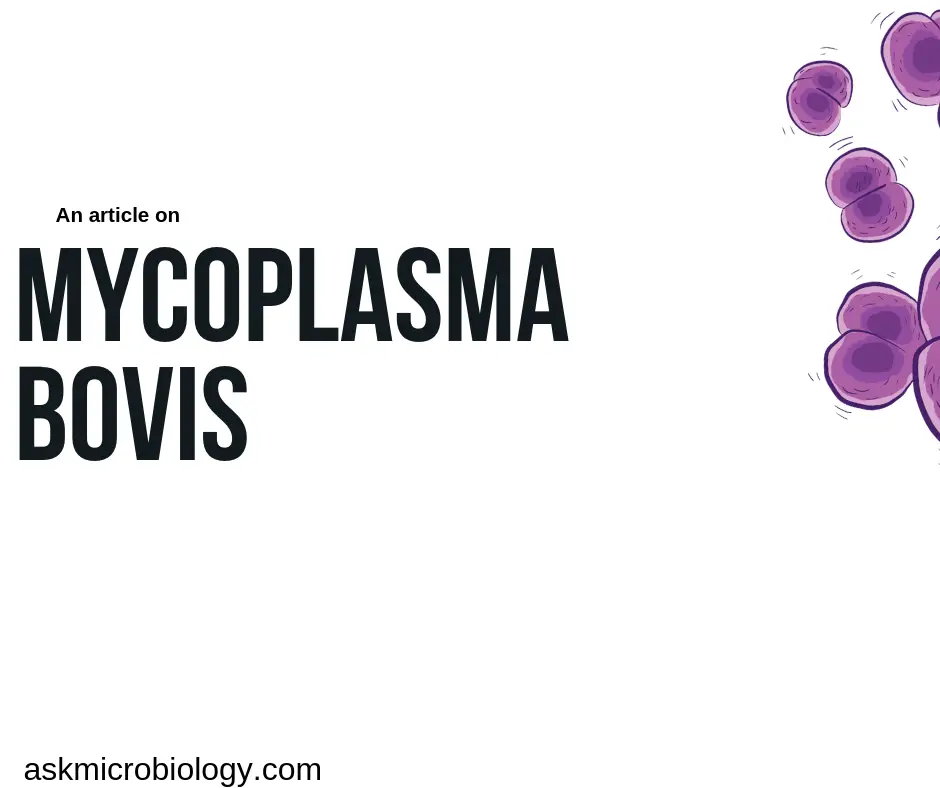Mycoplasmas are the smallest known bacteria also called as Mollicutes. Mollicutes is derived from two Latin words Mollis and cutes meaning soft body. Mycoplasmas don’t have cell wall, they are wall less bacteria. Their size ranges from to equal to the size of Pox virus. Their key feature is absence of cell wall and due to the absence of cell wall they are naturally resistance to penicillin and other Beta – Lactams. They have cholesterol in plasma membrane. Most of the Mycoplasmas move by gliding movement.
Mycoplasma bovis is one of significant members of Mycoplasma group. Mycoplasma bovis was first isolated in 1961 in USA. It was discovered from a cow suffering with severe case of mastitis. Mycoplasma bovisspread due to the movement of animals to various part of world. Due to this movement it spread to Europe and North America. Now it is an important pathogen infecting bovines all over the world.
Taxonomy
Mycoplasma bovis is an important pathogen of bovines. Its classification is as follows;
| Classification of Mycoplasma bovis | |
| Kingdom | Bacteria |
| Phylum | Tenericutes |
| Class | Mollicutes |
| Order | Mycoplasmatales |
| Family | Mycoplasmataceae |
| Genus | Mycoplasma |
| Specie | Mycoplasma bovis |
| Binomial Name: Mycoplasma bovis | |
Microscopic characteristics
Mycoplasmas are the smallest known bacteria having 250 to 300nm size. They can’t be stained with Gram’s stain. For staining Gimsa stain is used. They are polymorphic in shape as due to absence of cell wall don’t have any specific shape. Cell membrane is flexible containing cholesterol in it.
Physiology
Mycoplasmas are obligate parasites. They are dependent on external cholesterol source for the synthesis of their plasma membrane. So they need their host for the synthesis of plasma membrane and growth. They are dependent on host for getting most of their compounds. Mycoplasmas are difficult to culture on routine lab growth media. They require especial growth requirements and hence special media for their growth.
Diseases
The major disease caused in calves by Mycoplasma bovis is respiratory disease. But this bacterium is also responsible for causing mastitis, arthritis and pneumonia. It’s also responsible in causing otitis media but it is rare. Mycoplasma bovis is a pathogen of bovines so it causes disease mostly in bovines.
Bovine Respiratory disease (BRD)
Mycoplasma bovis is a natural commensal of bovine respiratory tract with showing any signs and symptoms. It is shed from there to months or even years through nasal discharge. It is also present in male and female genetial tract and can be transfer through coitus or through artificial insemination with frozen seman. It transfers to young calves during suckling of milk if mother is having the disease like mastitis.
Bovine Respiratory disease is caused by a variety of bacteria, viruses and Mycoplasmas including Mycoplasma bovis. This disease effects respiratory tract and animal is unable to breathe properly facing breathing difficulties.
Arthritis
Arthritis is an inflammation of joints. In arthritis joints become painful and swollen. The animal suffering with arthritis feels difficulty in walking. Even it becomes so painful that animal feel reluctant to go and walk for feed or water.
Mastitis
Mastitis is an inflammation of udder which is usually caused by infection. It results in the decrease production of milk. The milk has higher somatic cell counts which is responsible for low milk production. There is also a low level of casein in the milk of animal suffering with mastitis.
- A very rare reported severe form of pneumonia can also be recognized in Mycoplasma bovis infections. A poor antibiotics responsive type of pneumonia but very rare reported.
Transmission
Mycoplasma bovis transmits to calves during milking from the infected mother. It can also transfer by inhalation of aerosols produced by infected animals. It can also transfer by genital tracts of animals during mating process. It can also transmit by contaminated milking machines, wiping clothes and fomites. But the major route is aerosols and drinking Mycoplasma bovis contaminated milk.
Pathology
Mycoplasma bovis is usually naturally in upper respiratory tract as comensal of it. It forms colonies at respiratory mucosa and from there it can spread to other body parts. Resulting in various diseases such as mastitis, bovine respiratory disease, arthritis and pneumonia etc. Depending on the body system effected with Mycoplasma bovis. And from that system it spread to other calves infection them too. Its incubation period is usually 2 to 6 days depending upon the number of Mycoplasma present in animal and herd.
Signs and Symptoms
- In mastitis animal have lower casein content in milk. Due to low level of calcium in milk it undergoes deterioration. More somatic cell count in milk. Mastitis due to Mycoplasma bovis is the one in which animal has gangrenes and there will be necrosis of teat.
- In bovine respiratory disease there is infection of respiratory tract and it gets painful. Animal start coughing and have a fever of 40°C (104°F) as early sign of disease. Animal also go under stress and face lack of appetite.
- In arthritis there are swollen joints so animals feel reluctant to walk. Even animals don’t walk for getting food or water. Spinal problems, muscle atrophy, licking, chewing, biting and tiredness is also present in rare cases.
Further complications
Mycoplasmas bovis is mainly associated with diseases in bovins. It usually cause bovine respiratory disease, Mastitis, Arthritis and pneumonia but it can also cause otitis media if goes to ears. Even it can cause genital tract issues in some adults and decubital abscesses.
Risk factors
Following are the risk factors associated with the spread of Mycoplasma bovis.
- By Contaminated milking machines, veterinary vehicles, clothes and equipments.
- By contaminated milk and seman it can also be transfer.
- By transport of infected animals from one place to other.
- Infected animas are major source of its transmission and spread by aerosols, milk or seman.
Diagnosis
Sampling:
The sampling site depends upon the area infected with Mycoplasma bovis. The sample could be sawbs taken from noal secretions, conjunctiva, trachea and genetilia. Milk and semen samples could also be taken. For transport of samples phenol red and glucose containing medium B-broth is used. Sample is kept at 4°C and transported to lab as soos as it is possible. Tissue sample can also be taken and used for diagnosis after homogenisation.
Culturing:
Mycoplasma bovis give typical fried-egg shape colonies on medium B and Hayflick’s medium after incubation of 72 to 96 hours. For further confirmation we can also check its biochemical profile.
Immunological diagnosis:
Mycoplasma bovis can also he detected by immunological tests such as ELISA, SDS PAGE, immunobinding assay, western blot, and by using monoclonal antibodies for detection.
PCR:
Mycoplasma bovis can also be detected by using special primers PCR.
Treatment

As Mycoplasma is a wall less bacteria so antibiotics targeting cell wall can’t be used for ts treatment. Antibiotics like tetracyclines, erythromycin and macrolides can be used for its treatment. For treatment of Mycoplasma bovis the approved drugs in cattle are Draxxin (Tulathromycin) and Resflor Gold. Florfenicol (Nuflor) and Batril can also be used. The duration of treatment is 10 to 14 days.
Prevention
Following are measures to prevent Mycoplasma bovis infection:
- By Mainting a strictly closed herd policy u can minimise the risk of Mycoplasma bovis infection.
- The largest risk is while purchasing the cows. Through examination of anima before buying can minimise the chances of mycoplasma infection and its spread.
- Milk from mastitis cow must not be given to calf and it should be discarded.
- Use of hygienic milking machines, hygiene of veterinary vehical, clothes and equipments should be used.
- Seman should be checked before artificial insemination.
- It can be controlled by vaccination. Pulmo GuardMpB, Myco-BacTM B and Mycomune Mycoplasma bovis bacterin are available vaccines.

